2025 Nicolai / Geometron G1
Wheel Size: full-29’’, 29’’ front / 27.5’’ rear, and full-27.5’’ setups possible
Travel:
- Standard configuration: 162 / 175 mm rear (adjustable); 170 or 180 mm front
- ST configuration: 142 / 155 mm rear (adjustable); 140 or 150 mm front
- LT configuration: 182 / 200 mm rear (adjustable); 190 or 200 mm front
Geometry Highlights:
- Sizes offered: S, M, L, XL, XL
- Headtube angle: ~63° (adjustable, and varies by size)
- Reach: 500 mm (size Large, varies slightly based on geometry settings)
- Chainstay length: 446 to 480 mm (adjustable)
Frame Material: Aluminum
Price (including 20% VAT):
- Frame w/ EXT Storia V4: £3,600
- Frame & fork packages, rolling chassis, and full builds available; see Geometron’s website for details
Blister’s Measured Weight:
- G1 Frame (size Large, w/ all hardware, w/o shock): 9.22 lb / 4,180 g
- Complete bike, as built: 36.62 lb / 16.61 kg
Test Locations: Washington & California
Reviewer: 6’, 160 lbs / 183 cm, 72.6 kg
Test Duration: 6 months
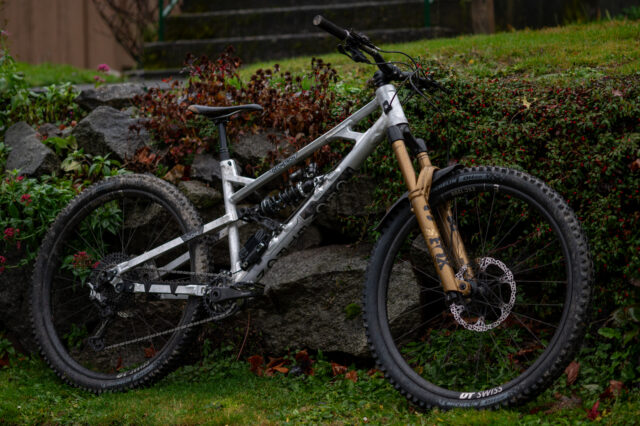
Intro
Mountain bike geometry underwent a massive, massive change in the last decade or so, and Geometron arguably did more than anyone else to bring those changes about.
Their original production bike, the G16, seemed unfathomably radical when it first launched back in 2015. Its main geometry numbers — 502 mm reach (on a size Medium), 62.5° headtube angle, 443 mm chainstays, and 77° seat tube angle — still sound thoroughly modern. Sure, the stack was short (608 mm on that same Medium frame) and it rolled on 27.5’’ wheels, but the G16 was, in many ways, the first truly modern Enduro bike.
I owned a G16 long before I ever worked for Blister, and when some of the ways in which it was dated (8.5’’ x 2.5’’ rear shock, 27.5’’ wheels) started to make it less suitable as a parts-testing platform, I moved on to its replacement, the G1, as my personal Enduro bike.
The G1 brought some geometry tweaks, more modern standards in terms of part fitment, more adjustability, and a bunch of other refinements — but still bore a strong resemblance to the G16 in a lot of ways. And while there are a lot of bikes with geometry that’s a lot more similar to that of the G1 than there were when it first launched, it still felt pretty out there in terms of being notably long, slack, and aggressive.
But now there’s a new G1, and the folks at Geometron (and Nicolai, who still build the G1) have found a lot to change — maybe a surprising amount, given the declining pace of geometry evolution in the mountain bike world. Let’s see what they’ve come up with.

The Frame
The overall silhouette of the G1 frame hasn’t changed a ton, but a lot of the details have. It’s still made in Germany from 7020 aluminum and the Horst-link suspension layout with a horizontally mounted shock carries over, but they’ve tweaked a lot of the construction details.
The most visually obvious changes are the new top tube-to-downtube gusset and integrated seatpost clamp / seat tube-to-top tube gusset, both of which look very similar to those used on the Nicolai Nucleon 16. The chainstay protection has been beefed up, the headtube is now a straight 56 mm affair to make more room for offset headsets, and there’s even more geometry adjustability on offer. The top tube has a more complex profile than the old round one, and so on.
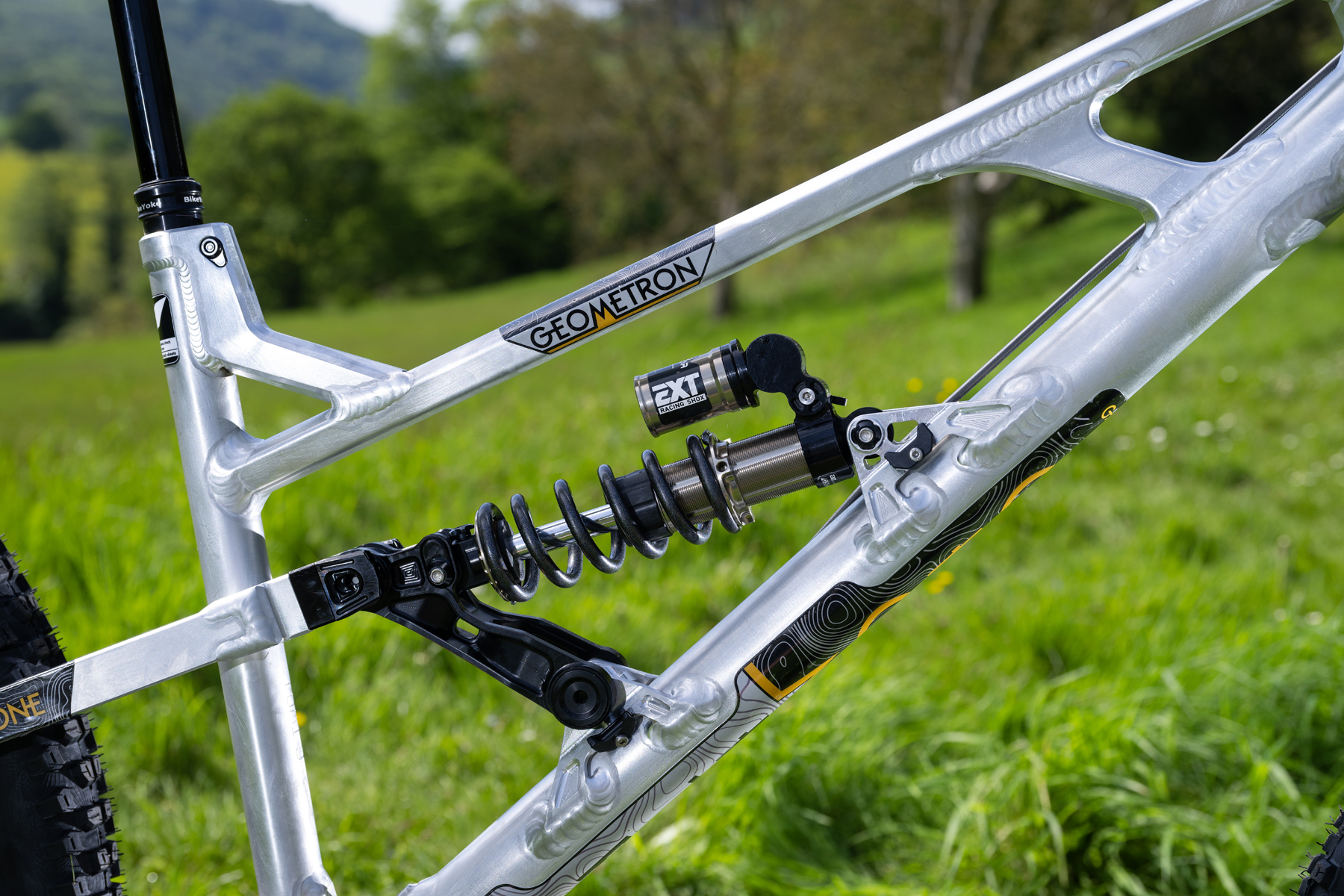
As with the outgoing G1, the new version uses “mutators” at both the seatstay / rocker link junction and the chainstay pivot to offer a massive amount of adjustability, covering geometry, wheel sizes, and now shock size / rear suspension travel as well.
The seatstay mutators are essentially spacers that bolt between the end of the seatstay itself and the pivot housing at the end of the stay, effectively varying its length and thus tweaking the G1’s geometry and / or compensating for different wheel sizes and / or rear shock lengths. (I know, it’s a lot.)
The chainstay mutators accomplish a similar goal but do so by replacing the dropout pivot housing with different clamshell pieces of varying lengths. Swapping in a longer chainstay mutator primarily lengthens the chainstays, but also lowers the bottom bracket and slackens the headtube angle a touch; going to a longer seatstay mutator primarily steepens the headtube angle and raises the bottom bracket, but also shortens the chainstays very slightly.

By varying the two mutators in conjunction with each other, the G1 has a ton of adjustability to tweak the geometry and compensate for different size wheels (to the point that it can be run with dual 29’’ ones, a mixed wheel setup, or two 27.5’’ wheels). And then a flip chip at the rear shock mount toggles between two different travel settings, with the higher position producing 162 mm of rear wheel travel, and the lower one bumping up to 175 mm and adding a bit more progression in the process.
That’s all more or less the same as the original G1, but the new version also offers two different lengths for the base chainstay and seatstay parts themselves, which extend the range of chainstay length adjustments far beyond what the original G1 offered — up to a colossal 480 mm when pairing the longer chainstay and seatstay with the longest chainstay mutators. All that geometry adjustability unlocks… even more adjustability, in the form of suspension travel options.

The 162 / 175 mm travel options referenced earlier are in the default configuration for the G1, with a 230 x 65 mm rear shock, which is meant to be paired with a 170 or 180 mm travel fork. But by mixing and matching mutator settings, you can run the G1 with a 210 x 55 mm shock to get 142 or 155 mm of rear travel (paired with a 140 or 150 mm travel fork) or a 250 x 75 mm one, for 182 / 200 mm of rear wheel travel, which Geometron recommends pairing with a 190 or 200 mm travel fork. The G1 is rated for forks up to a 605 mm axle to crown length (roughly in line with a 200mm-travel dual crown) but it is worth noting that the super long headtube on some of the larger size frames might make dual-crown fork fitment a challenge.
The rest of the frame details are focused on durability and ease of service. The brake hose and shifter housing are routed externally, with bolt-on clamps; the bottom bracket shell is threaded and features ISCG-05 tabs; replaceable inserts are used for threaded frame fittings wherever possible; and the pivot hardware all features secondary sealing to keep the elements out and grease in.
The G1 also now features a UDH for SRAM Transmission compatibility. The chainstay protection has also been beefed up and features a pass-through for the derailleur housing. The new rear triangle can be retrofitted to the original G1 front end for owners of the original bike who want to take advantage of the UDH and / or longer chainstay options.
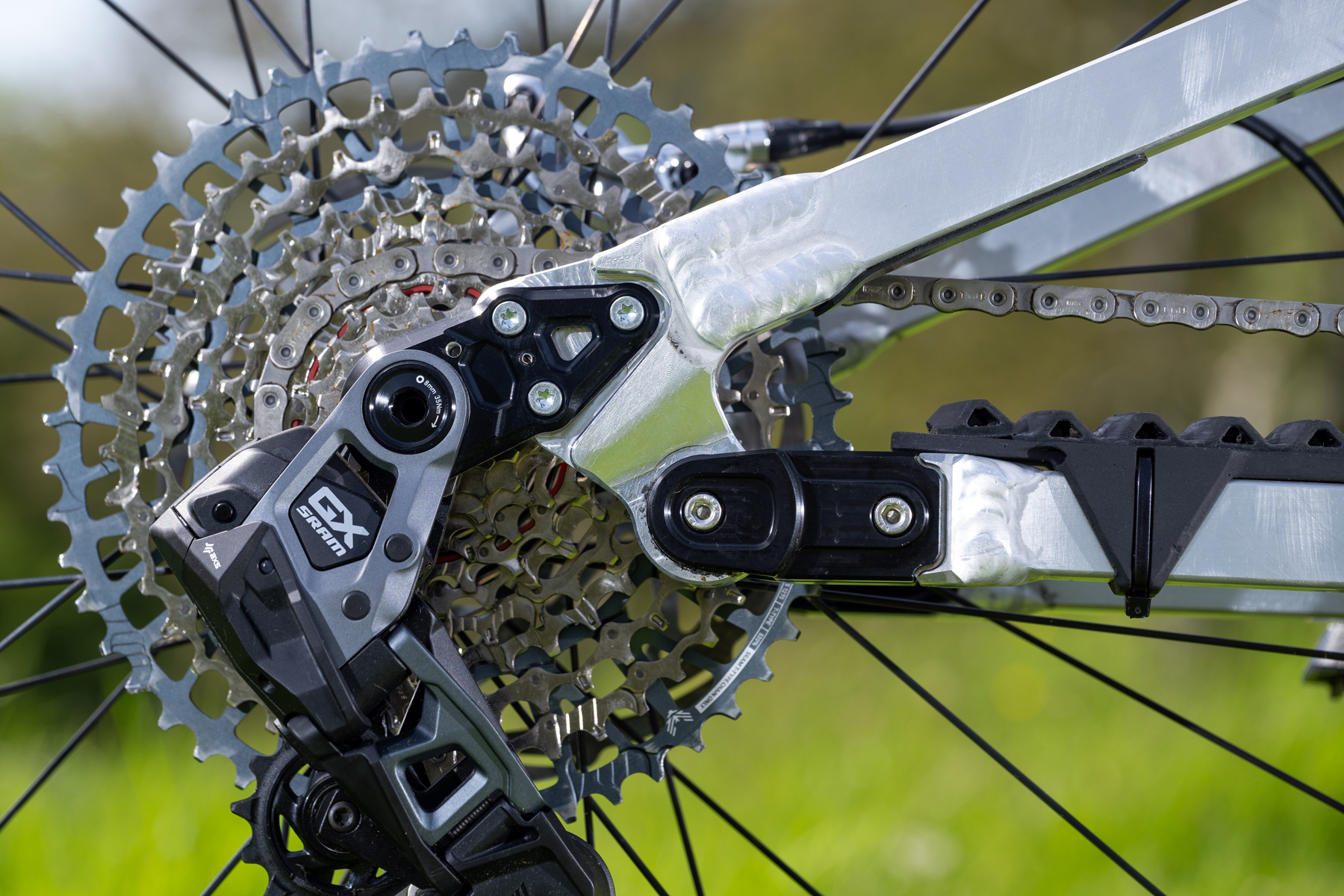
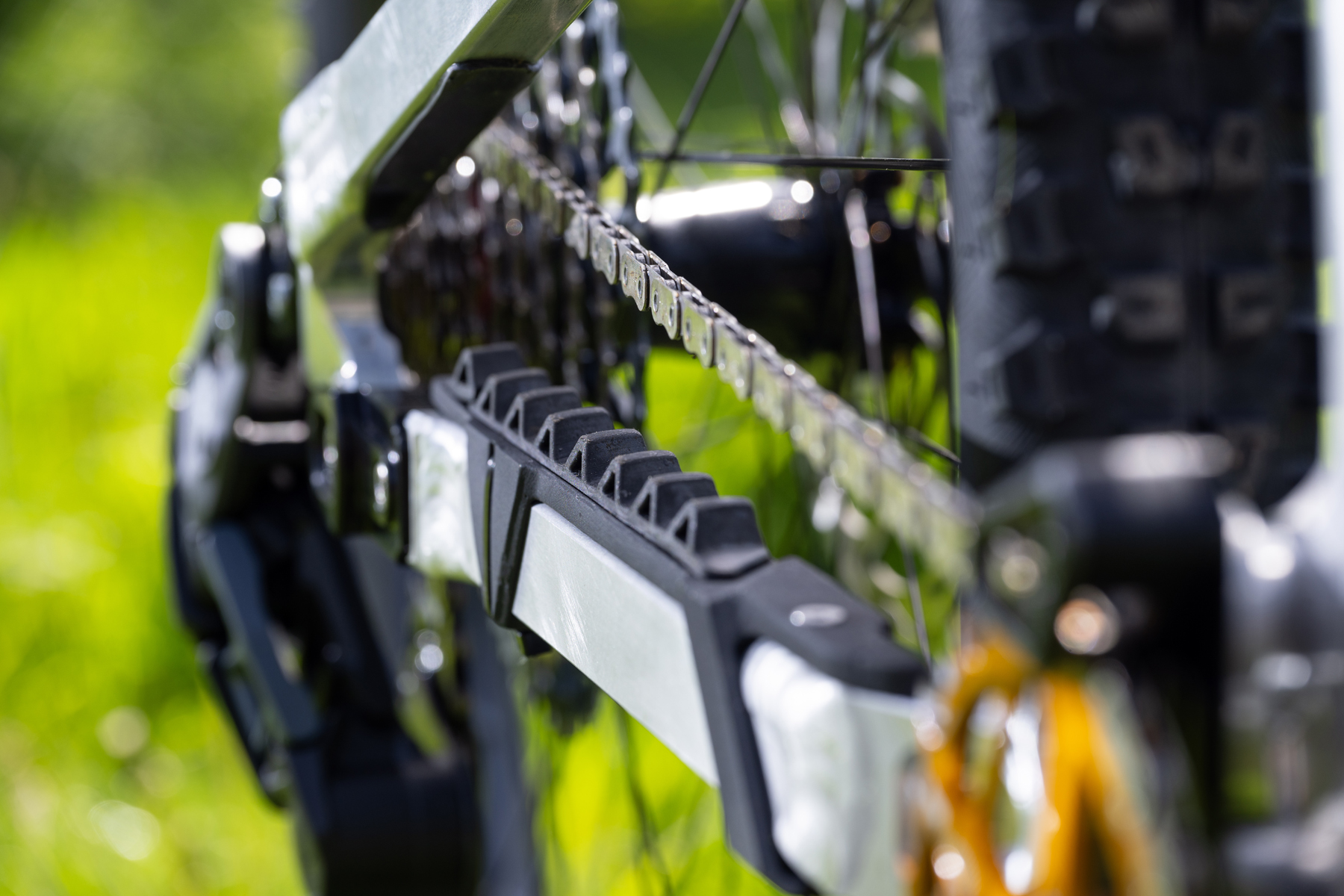
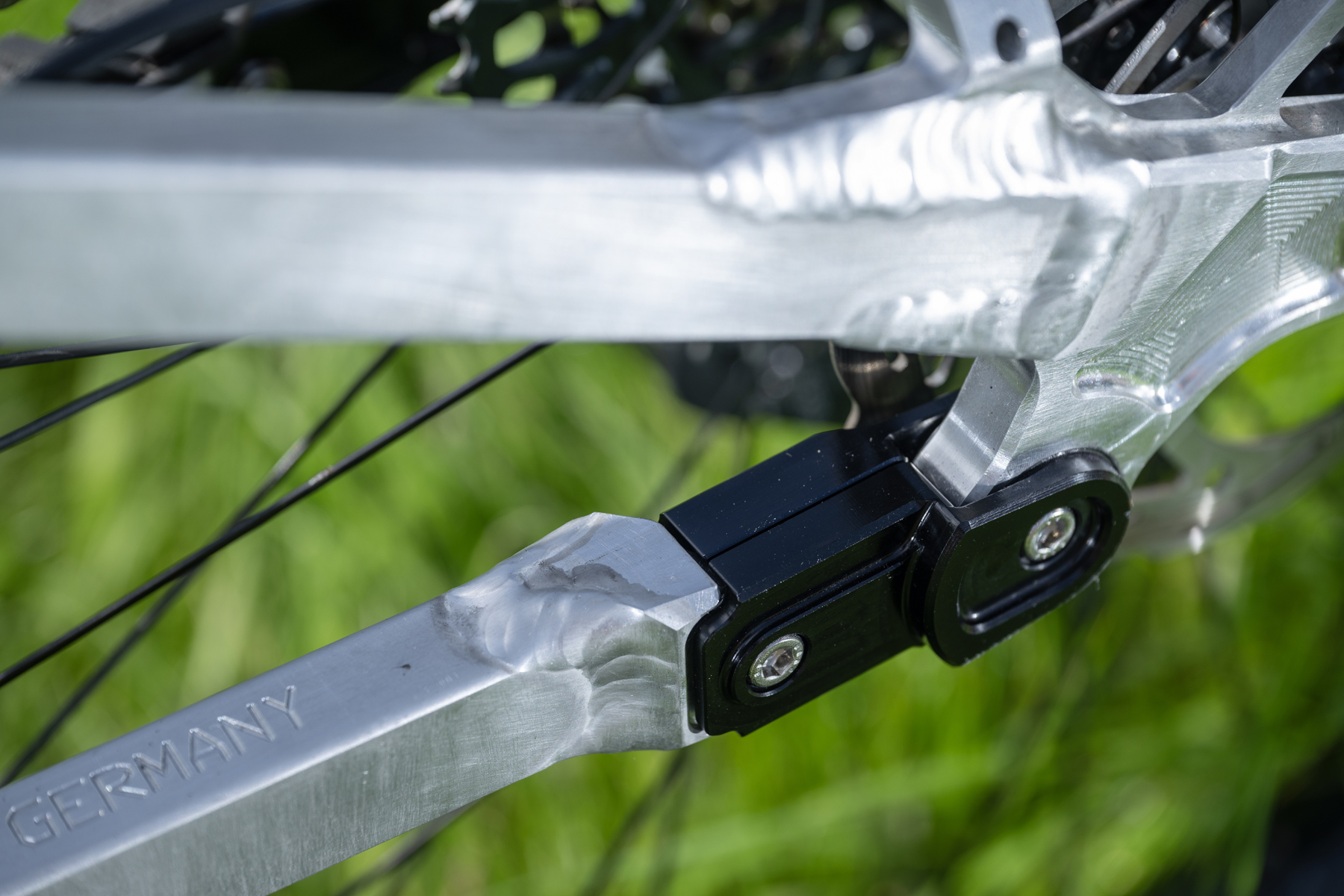
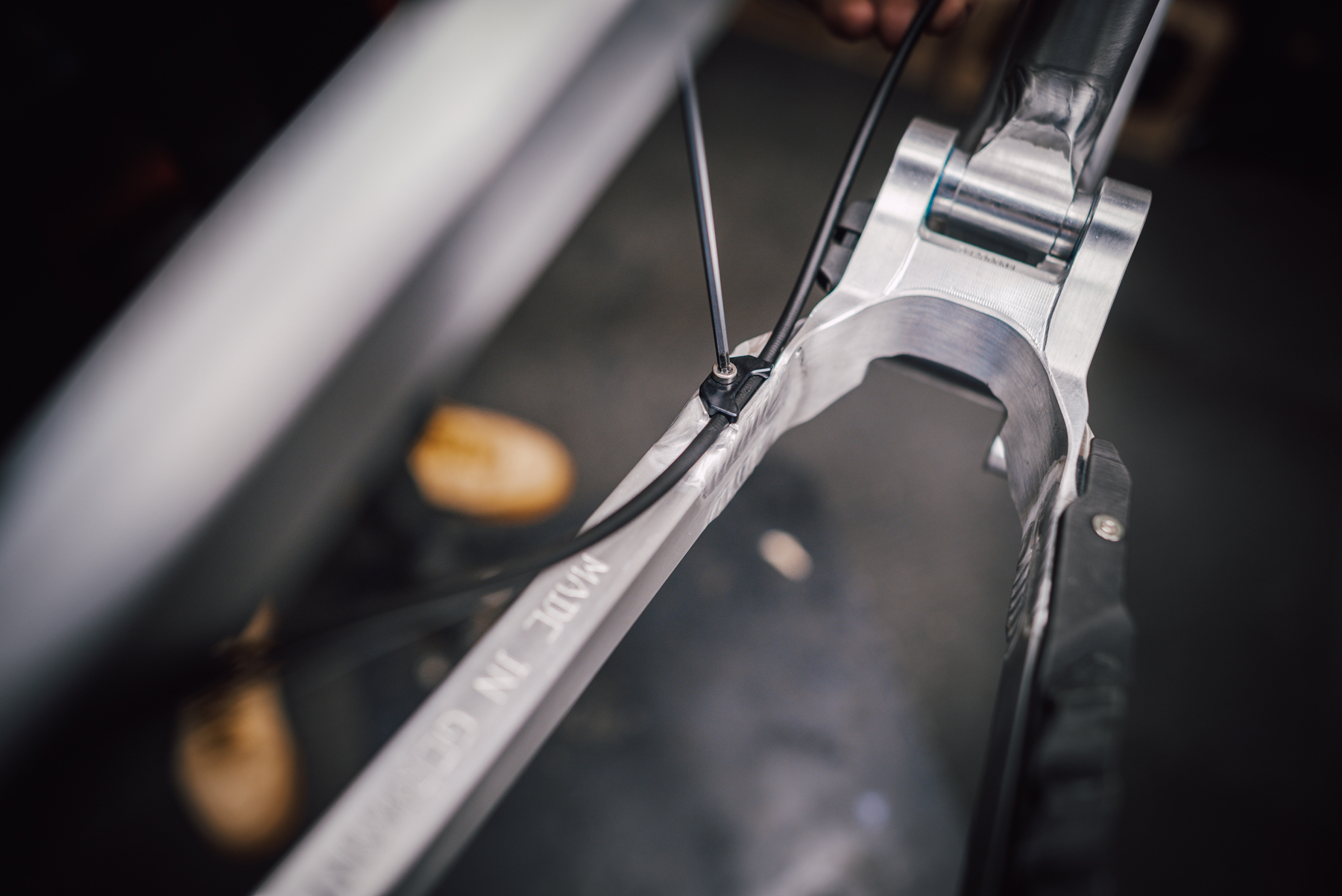


Geometron doesn’t go into a ton of detail about the suspension kinematics of the new G1, but it doesn’t sound like they’ve changed a whole lot from the old one. The total progression is stated at 31% (in which travel setting isn’t clear) and anti-squat and anti-rise are listed at 100% and 62% at the sag point, respectively. The leverage curves for the various configurations are published in their tech sheets (see below); the other kinematic data isn’t published, but Geometron says it’s generally quite similar to the outgoing bike.
Fit & Geometry
The new G1 is offered in the same five sizes (Small, Medium, Large, XL, and XXL) as the outgoing one, but unlike most recent bike updates in recent years, they haven’t gotten longer and slacker — in fact, quite the opposite.
Reach now starts at 455 mm on the Small and grows by roughly ~20 mm between each frame size, up to 535 mm on the XXL. That’s about 15 to 20 mm shorter in a given size than the outgoing G1 (but still quite long overall); the headtube has steepened a touch, from 62.5° to around 63° in the default configuration, though it now varies by frame size, with the smaller sizes getting a slightly slacker headtube (62.6° on the Small, up through 63.8° on the XXL). Seat tube angles start at 77.8° on the Small frame and get fractionally steeper with each step up in frame size, to 78.8° on the XXL.
But while the reach has gotten shorter across the board, the stack height has grown — by a lot. The Small frame’s stack now starts at 628 mm — a number between the Medium and Large on the outgoing G1 — up to a colossal 685 mm on the XXL, with stops at 646 mm, 657 mm, and 678 mm along the way. That’s way, way taller than the outgoing bike — and pretty damn tall in general. I’ll now take my victory lap for predicting that we’d see reach and headtube angles stop getting more radical, with the new frontier for more gravity-oriented bikes being taller stacks and longer chainstays just a few weeks before the G1 launched on Bikes & Big Ideas. (I promise I hadn’t seen the new G1 yet when I said that.)
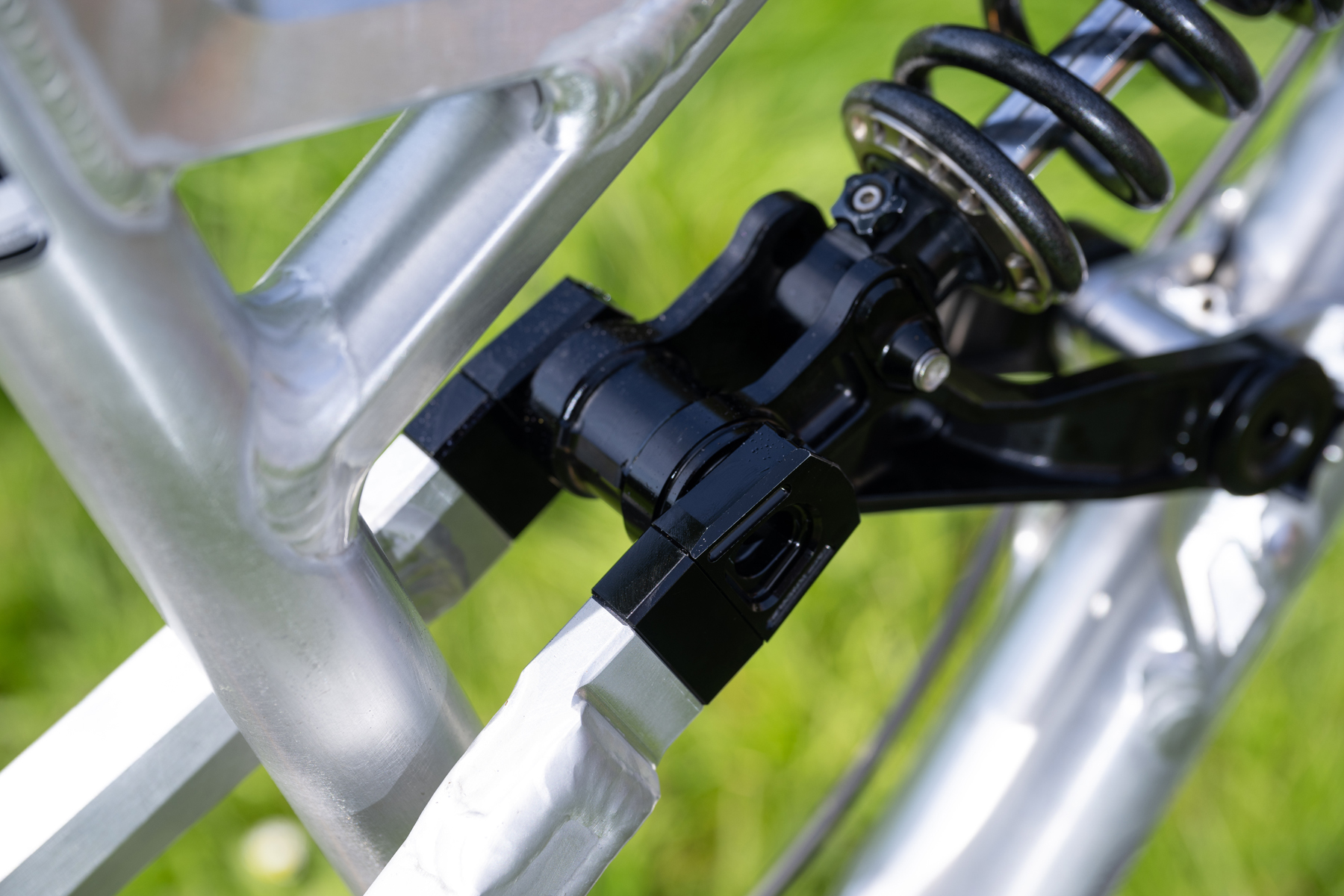
And speaking of chainstay lengths: any frame size can be configured with any of the possible chainstay lengths, but the Small through Large frames default to the shorter base chainstay / seatstay assembly, which in turn can be configured to have 446 mm chainstays (default on the Small frame), 454 mm ones (Medium default), 460 mm (Large default), or 466 mm ones via mutators. The longer chainstay assembly can go as short as 460 mm, with options for 468 mm, 474 mm (XL default), or 480 mm (XXL default) and come as standard on the XL and XXL frames, but you can swap things around at the time of ordering if you’d like.
Size-specific chainstay lengths have become commonplace, but the new G1 gets a lot more size-specific geometry, from the headtube angle to the bottom bracket height, and more. Interestingly, the bottom bracket drop varies by size, in a decidedly non-linear manner. The Small frame — which defaults to a mixed-wheel configuration — gets a stated 23 mm BB drop, though it’s not clear if that’s relative to the front axle, the rear one, or the line between them (dear bike industry: please pick a standard way to state BB drop on mixed-wheel bikes and stick with it). The rest of the size range defaults to a full 29’’ setup, but, again, all frame sizes can be configured to your liking there; the bottom bracket drop on the Medium frame starts at 28 mm, with the bottom bracket lowering fractionally on the Large (30 mm drop) and XL (31 mm drop) before coming back up a little (29 mm drop) on the XXL.
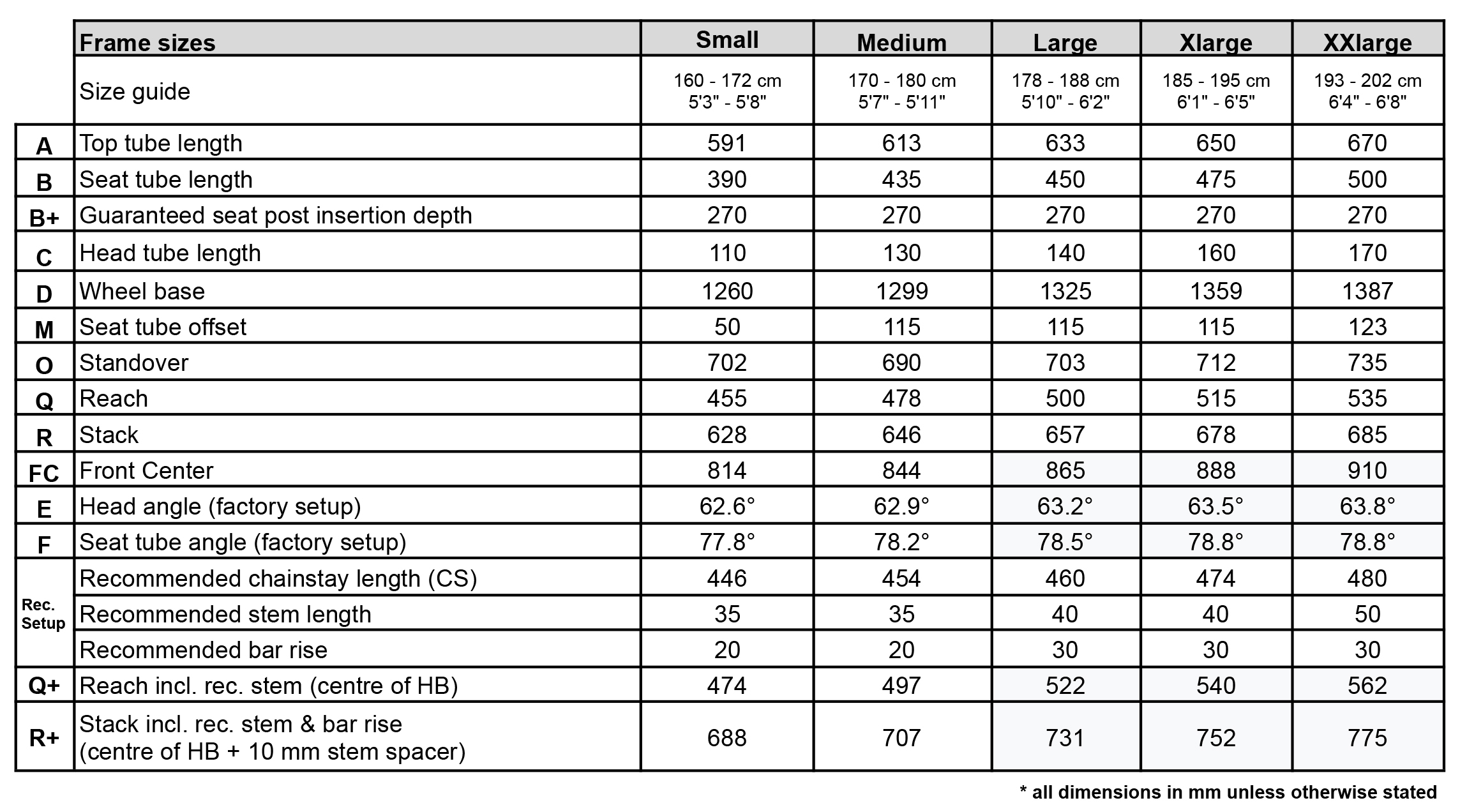
Again, those numbers are all in the default configuration for the G1, with the 203 x 65 mm rear shock, a 170mm-travel fork, and the standard options for mutator settings; you can change a whole lot from there if you’re so inclined. The full spreadsheet with all the options for the standard 230 x 65 mm shock configuration is here; if you’re curious about the other configurations, the short travel tech sheet is here, and the long travel one here.
The Builds
The G1 frame comes standard with an EXT Storia V4 shock, again with spherical eyelet bearings as featured on the Storia V3 from the original G1. Geometron has a custom build configurator that lets you spec out a full or partial build of your choosing. The frame kit includes a Hope headset and retails for £3,600 (including 20% VAT); you can add an EXT Era V2.1 fork for a total package price of £4,975 (again with VAT), or keep adding parts from there.

FULL REVIEW
I’ve had a long history with Geometron. I owned a G16, the predecessor to the original G1, long before I started working for Blister, and it was a revelation. I had a background in racing DH, and the G16 was a far more capable, DH-oriented bike than anything I’d been on to that point that could readily be pedaled back to the top of the hill, in no small part due to its geometry, which was truly unlike anything else at the time.
I moved to the first generation G1 when some of the limitations of the G16 as a parts test bike — 27.5’’ wheels, a non-metric shock size, etc. — began to pop up. The G1 felt like a logical, more refined continuation of the G16, with updated geometry, better compatibility with modern parts standards, and considerably more adjustability.
And I loved it, for a while. But over the course of my time with the original G1, my preferences for bike setup evolved, and the fit and handling of the Medium G1 I owned were no longer quite what I wanted from it. I eventually moved on from that G1, swayed in no small part by how well I got along with the Contra MC when I reviewed it, and I ended up buying an MC to supplant the G1 as my personal Enduro bike.
I still own (and love) the MC, but when Geometron launched the second-generation G1, my interest was piqued all over again — the updates to the new bike looked like almost exactly what I would have done had I been in charge. Having spent a ton of time on the new G1, my suspicions were confirmed — it keeps a lot of what made the original great while refining most of its rough edges, and the result is pretty special.
So what does the new G1 do so well, what are its limitations, and who is it going to work best for? There’s a lot to cover here, so let’s dive in.
[The massive amount of adjustability built into the G1 makes neatly characterizing its performance more complicated than it is on many other bikes. For the bulk of the review, I’ll describe the G1 in its default Enduro configuration, as I prefer to set it up in that mode. Where relevant, I’ll describe those setup preferences, what led me to them, and some of the other tweaks I tried on the way to establishing those preferences. And, finally, I’ll weigh in on the G1’s optional short- and long-travel setups in their own sections near the end.]
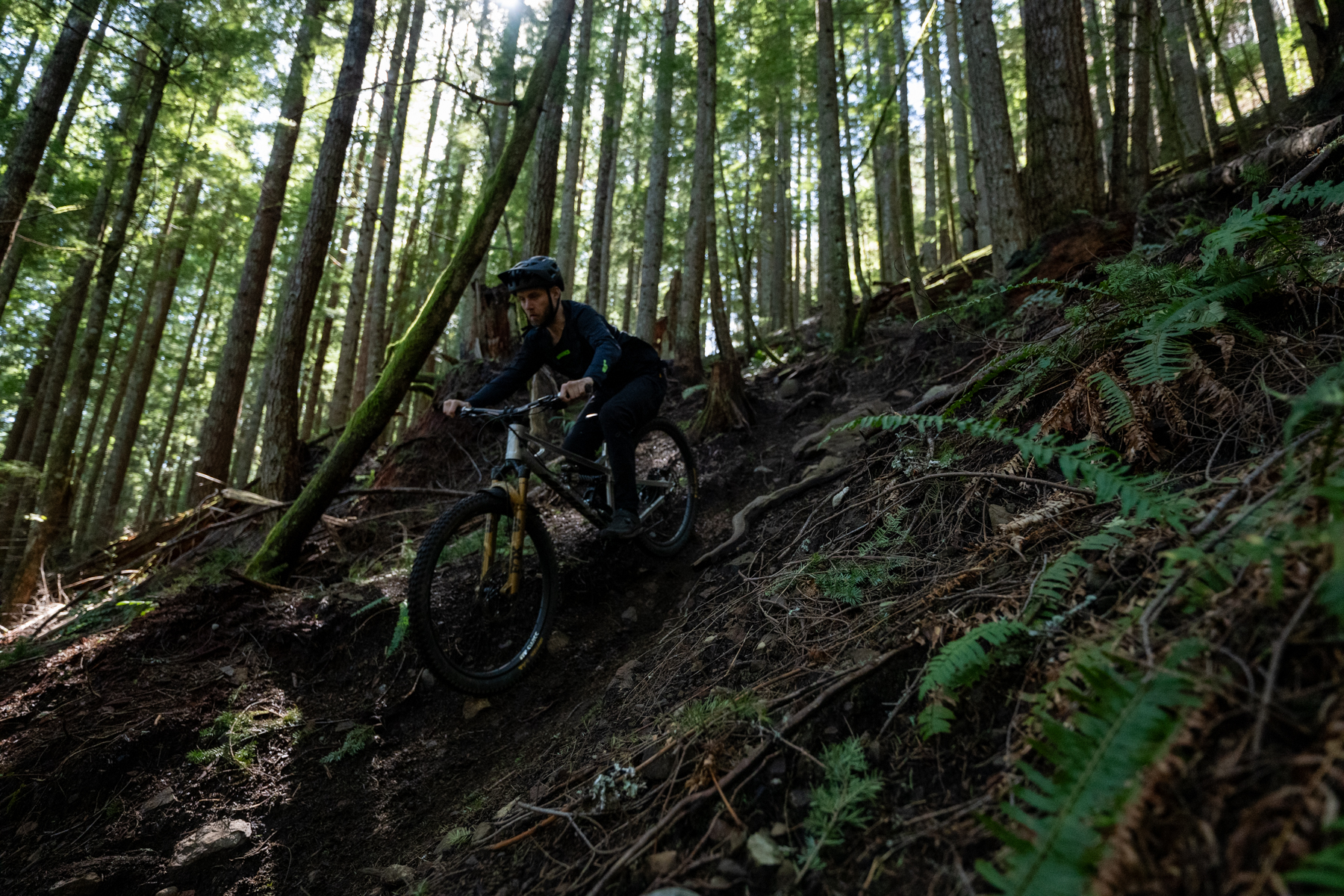
Fit & Sizing
David Golay (6’, 160 lb / 183 cm, 72.6 kg): Fit was the biggest factor that ultimately led me to move on from the prior-generation G1. The Medium frame I opted for was the right call when I bought it back in 2021, but my preferences have evolved substantially in the intervening years, and by 2024, it was smaller than I wanted.
The biggest thing that changed is my preferred bar height — particularly on more gravity-oriented bikes, it has gotten substantially higher. The evolution toward longer chainstays on those sorts of bikes did a lot to facilitate that change in my tastes. On bikes with shorter stays, it (generally) takes more care to stay over the front end and keep the front wheel weighted; keeping the bars lower makes that easier. Because bikes with longer stays tend to facilitate a more centered stance, they allow a more upright body position without creating issues in adequately weighting the front wheel.
As I incrementally raised the bars on the prior-gen G1, its fit felt progressively smaller. The change was most significant while seated — by raising the bars (which I did through a combination of higher rise bars and additional spacers under the stem), I was bringing my hands in closer to my shoulders, making the bike feel more compact. Eventually, the seated pedaling position just felt more cramped than I wanted it to be.
So on the new G1, I opted for a Large frame — not because its reach (500 mm) is closest to that of the prior-generation Medium (495 mm), but because the much higher stack height on the new bike would let me get the bar height I wanted with far fewer spacers under the stem, and in doing so, effectively shorten the reach and effective top tube much less. I expected and wanted the new G1 in a Large to fit bigger than the Medium prior-gen bike, and it does.

I haven’t second-guessed that decision at all. The Large G1 fits me extremely well. It is, undeniably, a big, long bike, but — as we’ll get into in much more detail below — that fits well with what the G1 does (and doesn’t do) best. The steep seat tube and tall stack height mean that the seated cockpit doesn’t feel as big as the 500 mm reach might suggest (as I’ve said many times, reach on its own is an inadequate way to size a bike), and I felt comfortable on the Large G1 right out of the gate.
Climbing
The G1 is, in many ways, one of the better-climbing ~170 mm-travel Enduro bikes out there; there are also a few caveats.
I’m a big fan of the G1’s suspension performance under power. It offers above-average efficiency while still maintaining traction effectively in most situations. There are bikes that have a leg up on the G1 when it comes to maximizing compliance and traction under power, but they’re almost always less efficient; the G1 pedals quite well, without chasing the final marginal gains in efficiency to the detriment of grip and compliance.
The G1’s relatively long chainstays and upright seated position help with that efficient feel, particularly when grinding up a steep, relatively smooth climb. It’s extremely easy to stay centered on the bike, which in turn makes it easy to keep the front wheel planted without needing to hunch forward. Compared to a lot of bikes with a more rearward weight bias when climbing, it also doesn’t feel like you’re sagging deep into the shock’s stroke when the climb gets ultra steep.
The flip side is that, while the G1 isn’t a bad technical climber for what it is, its long wheelbase can start to feel cumbersome, particularly on tight, ledgy climbs where you need to do a lot of lofting the front wheel onto stuff or managing tight, awkward turns. The more your climbs are of the fire road or smoother climbing trail variety, the more I’d characterize the G1’s climbing performance as good to excellent, at least for such a burly bike; the more tight, awkward jank you’re navigating, the more I’d temper that praise.
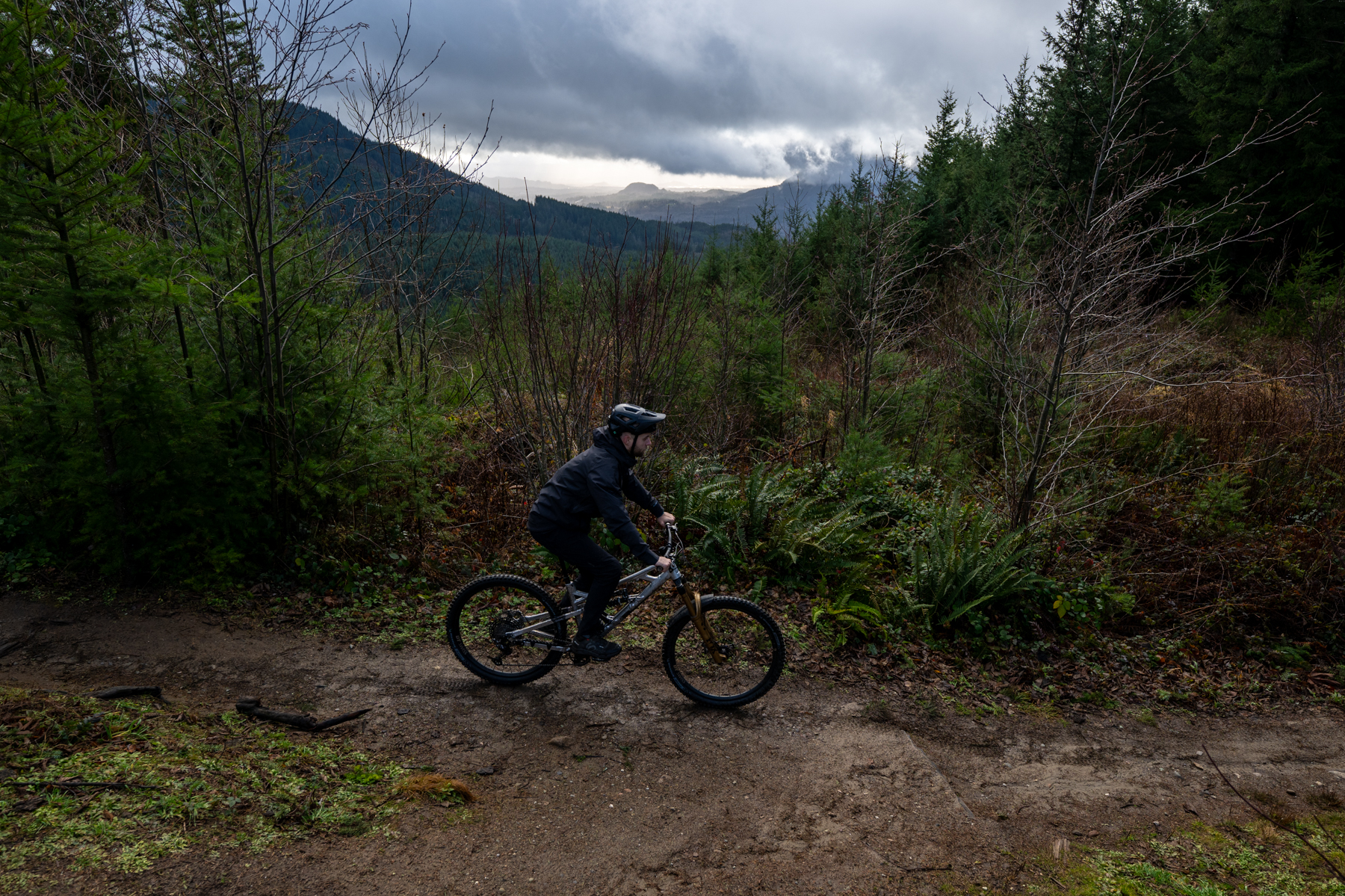
Of course, that general tradeoff is hardly unique to the G1 — longer, lower bikes tend to be tougher to manage in technical climbing situations, and the higher priority you place on that sort of climbing performance, the more I’d recommend more of an all-rounder Trail bike than a full-on Enduro one, be it the G1 or another competitor. The G1’s shorter-travel Trail mode (more on that below) is a step in that direction, but it’s still a much longer, lower bike than most other options in the ~140-150 mm travel range.
Descending
As you’d expect given its geometry and 170+ mm of front and rear travel, the G1 is an extremely capable, confidence-inspiring bike at speed on burly descents. It’s quite stable, with a huge sweet spot to move around on the bike, but — particularly with how I prefer to set up the rear suspension — it’s also more maneuverable and easier to manage in tighter, more awkward spots than its wheelbase and overall stability might suggest, largely by facilitating getting light on the bike and throwing it around when needed. So, on that note:
I prefer the 175 mm longer-travel setting over the 162 mm one (adjustable via flip-chip at the rear shock mount) for the G1’s intended use. The 175 mm setting offers a bit better initial sensitivity and traction, and a slightly lower dynamic ride height due to the increased sag, which combine to make the G1 a notch more planted and composed than it is in the 162 mm one. The shorter travel setting makes the bike a touch more lively and energetic, but comes at the expense of more chassis stability and rear wheel grip than I’d like.
That said, I have found myself preferring a slightly firmer spring rate than Geometron recommends for my weight (160 lb / 72.6 kg). Their chart puts me squarely between a 325 and 350 lb spring for the 162 mm travel setting, while recommending a 25 lb firmer spring for the 175 mm setting (so, between 350 and 375 lb in my case). From there, they also note that they’d recommend going up another 25 lb in spring rate “if you would prefer a bit more pop and a quicker reaction to direction changes.”
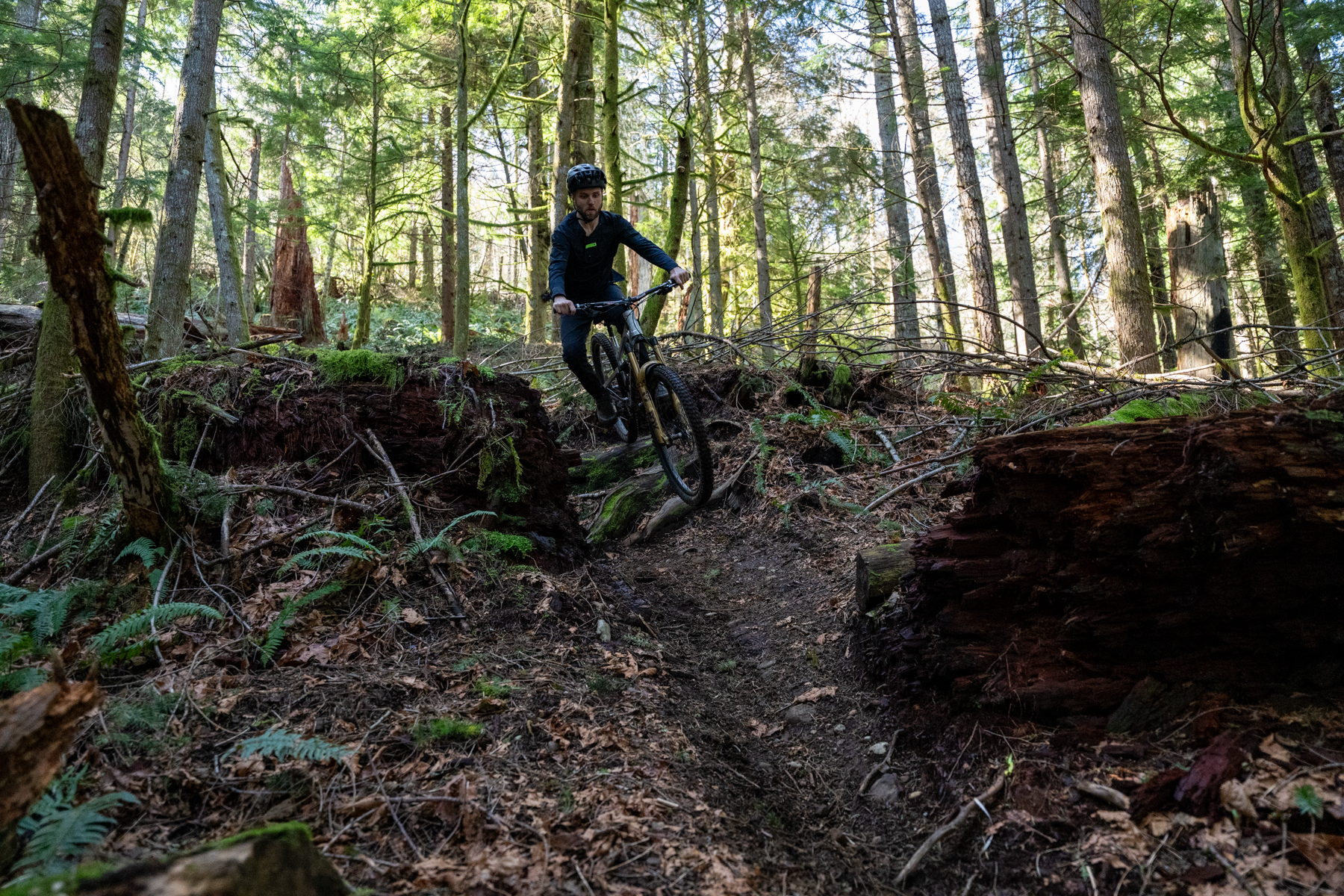
That proved to be true for me, and I’ve settled on a 400 lb spring in the 175 mm travel setting as my preferred setup. A 375 lb one also works, but it makes the G1 a little more planted than I want, and it takes away some support when pushing into the bike to load it up and generate energy on rebound. The firmer 400 lb spring also feels more balanced with my preferred setup on the Fox 38 Grip X2 fork that I wound up running for most of the test period (in the standard Enduro configuration, anyway — more on the Trail and DH setups in a bit).
What all that adds up to is a bike that’s quite stable and composed if you want to just point it and let it run, but still offers a surprising amount of pop and energy when the time comes to ride it more dynamically, maneuver it through tighter bits, and/or just boost off something. Softening the rear suspension (i.e., dropping to a 375 lb spring in my case) makes the G1 more emphatically planted and composed at the expense of some of the liveliness that I appreciate about the 400 lb spring setup. The adjustable hydraulic bottom out on the stock EXT Storia V4 that comes stock helps quite a bit in making both spring rate options work — I just run quite a bit more HBO with the 375 lb spring, and less with the 400 lb one.
The more I wanted the G1 to be a super planted bike that just bulldozes whatever’s in front of it, the more I’d be inclined to drop down to the 375 lb spring — but if I really want to make the G1 go smash stuff, the DH configuration does that even better. For the bulk of the riding I’m doing on the G1, the 175 mm travel configuration with the suspension setup to be more lively hits the balance of traits that I’m looking for. But the G1 is still a long, stable bike, and while the firmer, more lively suspension makes it easier to maneuver in tight spots than it is with the suspension softened up, there’s still no hiding the G1’s big wheelbase.
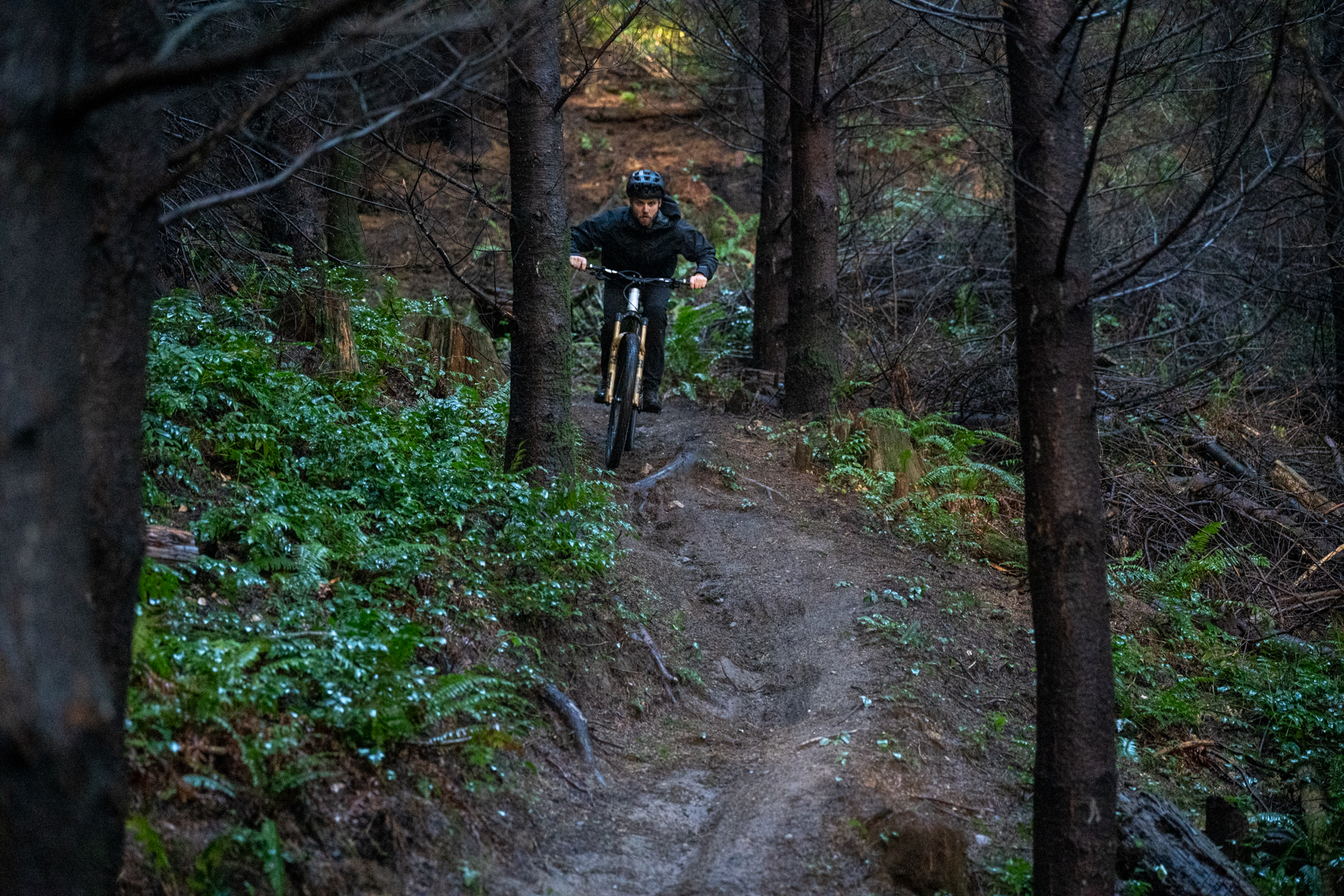
And that all starts to get at the heart of the G1’s personality and how it likes to be ridden. Simply put, the G1 needs a bit of speed and pitch to wake up and feel engaging on the way back down. It’s by no means a big outlier on that front by Enduro bike standards — many of the more game-on bikes in the category are at least as demanding of appropriately burly trails. But there are also a lot of 160+ mm travel bikes that are substantially more engaging on mellower trails, while still being able to tackle burly ones; those sorts of bikes just tend not to be as composed and confidence-inspiring when you’re really getting after it. As we like to say around here, it’s good to know thyself and be honest in your assessment of how much bike you really want or need.
[Check out our Deep Dive on the G1 for a whole lot more on those comparisons, and if you’ve got questions, we’re here to help.]
Geometry & Adaptability
The G1 frame has a massive amount of adjustability built in — even before we get into the short- and long-travel configurations, which I’ll cover in more detail below. Over the course of my testing, I tried a huge range of setups, including experimenting with both the shorter 327 mm swingarm and the longer 343 mm one, both 29’’ and mixed-wheel setups, and a lot of different mutator combinations to arrive at different geometry configurations.
[A quick refresher on the G1’s adjustability: there are four different size chainstay “mutators,” the bolt-on clamshell pieces at the dropout pivot, which adjust the chainstay length, and seven different options for seatstay mutators, which bolt in between the ends of the seatstays and the rocker link pivot assembly to vary the headtube angle and bottom bracket height, and/or compensate for different rear wheel sizes. And then there are two different length options for the main chainstay assembly itself — the 327 and 343 mm swingarms referenced above — which offer two different (overlapping) ranges for the chainstay length settings.]
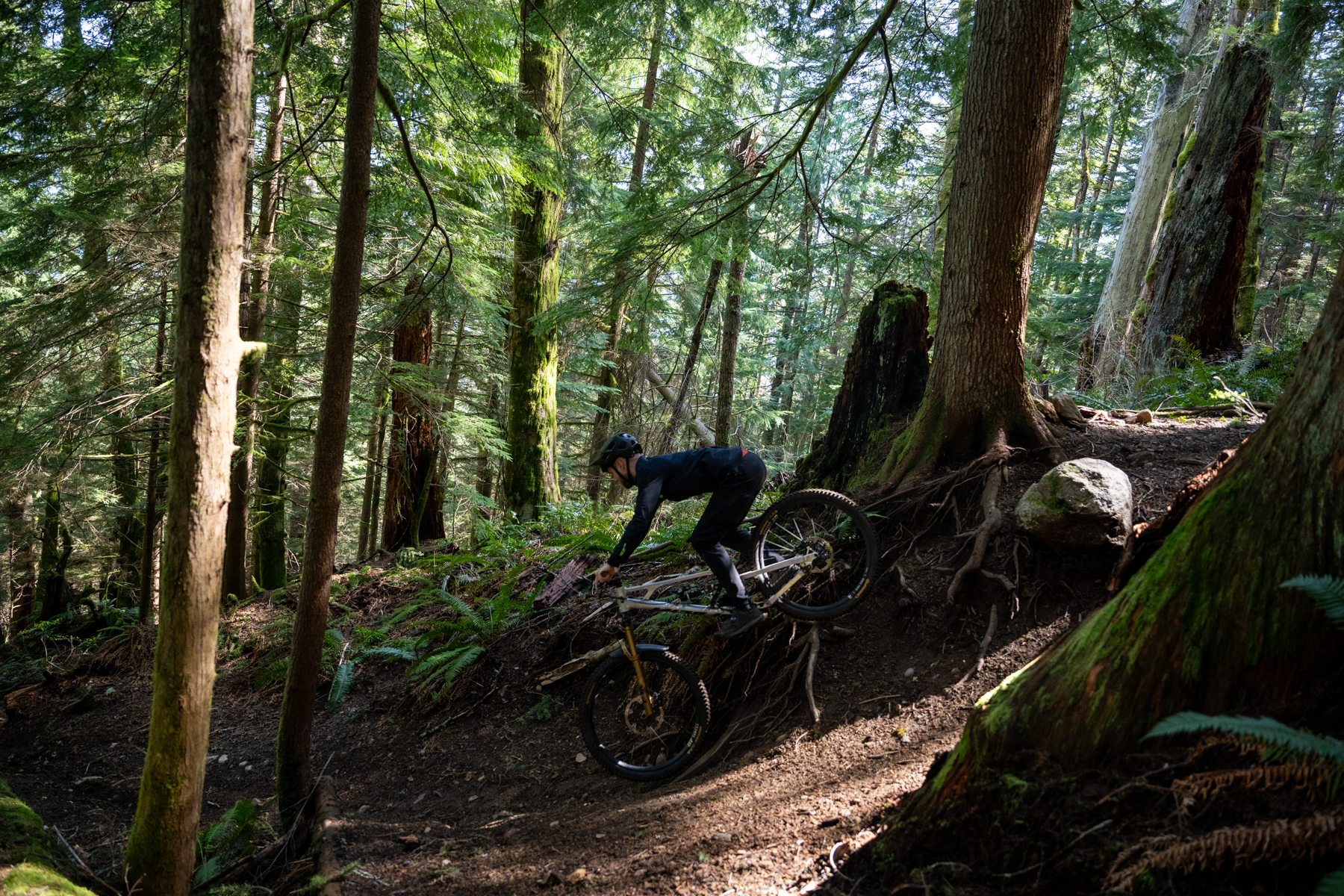
Long story short, my preferred setup wound up being close, but not quite identical to, Geometron’s recommended default configuration for the Large frame. The standard setup rolls on 29’’ wheels at both ends and uses the shorter 327 mm swingarm with 47 mm chainstay mutators and 15 mm seatstay ones to produce 460 mm long chainstays, a 339 mm bottom bracket height, and a 63.2° headtube angle.
My final setup uses a lot of different parts — the longer 343 mm swingarm, 33 mm chainstay mutators, and 15 mm seatstay ones — but produces 461 mm chainstays, a 333 mm bottom bracket height, and a 62.8° headtube angle, which aren’t too far from the stock setup.
[Running a closer-to-standard setup of the 327 mm swingarm, the 47 mm chainstay mutators, and 12 mm seatstay ones produces similar results to where I wound up; I mostly went the way I did to more easily facilitate swapping between the standard Enduro configuration and the longer-travel DH one. Again, more on that below.]
My main reason for going lower and slacker than standard is that, as described above, I wound up preferring a slightly firmer spring rate for the rear shock than Geometron recommends for my weight, which results in me running a bit less sag than I would with the recommended spring rate, and through it, a higher dynamic ride height most of the time. The geometry tweaks I made were mostly to counteract that higher ride height. With the softer 375 lb spring (again, I preferred a 400 lb one overall), I’d run a slightly longer seatstay mutator to bring the back of the bike back up to compensate for running more sag.
That’s worth underlining. On most bikes, the window of suspension settings that I can make work feels a lot narrower than it is on the G1, because I’m having to balance the actual suspension performance I want with the follow-on effects of dynamic ride height and the ways that impacts handling. The G1 is so adjustable that you can tune the two much more independently. I can make the G1 handle very similarly with either a 375 or 400 lb spring on the shock — which isn’t the case with most bikes — and choose the suspension feel I want separately.

Big picture, the geometry adjustments on the G1 feel more suited to tailoring the handling and weight distribution on the bike to your liking, rather than turning it into something categorically different. There’s a lot of room to make changes, particularly because you can run any of the possible chainstay lengths on any size frame, but the G1’s overall character comes through across a big range of options. It’s an aggressive, stable Enduro bike that’s going to work best for folks who want something to ride fast on burly trails, and that’s true across as wide a range of geometry settings as I cared to try. But it’s a bike that you can tweak to ride substantially differently in a lot of the finer details, and if you’re the sort of person who wants to dial your setup in just so, I’ve yet to find anything else like it.
Overall, most changes do what you’d expect. Making the chainstays longer makes the bike more stable and pushes the weight distribution forward slightly; making it lower and slacker also bumps up the stability, but slows down the steering and shifts the weight bias rearward, and vice versa.
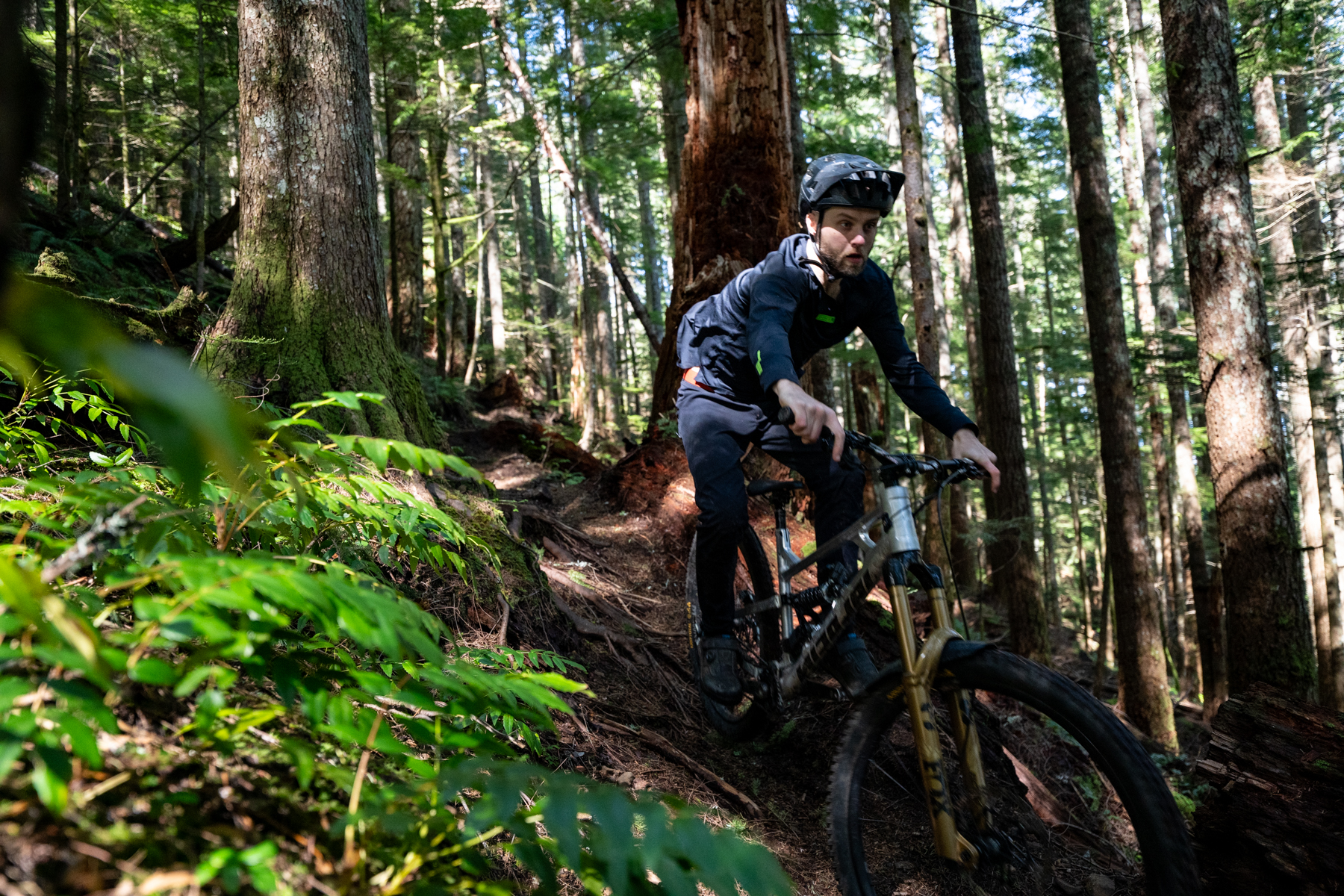
As for the mixed wheel setup, the main thing I’d highlight is that I wound up preferring one notch longer chainstays with a 27.5’’ rear wheel than I do with a 29’’ one. As tends to be the case with mixed wheel setups, the smaller 27.5’’ rear wheel is quicker to turn in, and thus requires more countersteering through the bars to catch the bike as it leans in. I like the more neutral handling feel of the full 29’’ setup better overall, but bumping the chainstays longer helps counteract the tendency I just described. There’s enough adjustability on offer that I think most folks will be able to find a setup that suits their typical wheel size preference, so long as they’re after a pretty long, stable bike overall.
The Build
Nicolai and Geometron mostly offer the G1 as a frame kit with options for custom builds, rather than as complete bikes with set specs. I received the G1 as a frame only, and built it up with a mix of my typically preferred parts and a bunch of review ones. As such, I won’t dwell on the build specs too much, but in general, there’s nothing about the G1 that would lead me to do anything out of the ordinary with the build.
(For reference, our measured weight of 36.62 lb / 16.61 kg for the complete bike is with the stock EXT Storia V4 shock, an EXT Era 2.1 fork, DT Swiss EXC 1200 Classic wheels, Michelin DH22 tires, a Shimano XTR drivetrain, Hayes Dominion T4 brakes with Galfer Shark 223 mm front / 203 mm rear rotors, a Wolf Tooth Resolve 242 mm dropper post, an aluminum cockpit and HT X3 pedals.)
The bad news is that I broke the first G1 frame I received, with a crack developing at the weld where the top tube / downtube gusset meets the downtube. Geometron and Nicolai worked together to get a replacement sent out in short order, and that one has held up without incident.
Nicolai’s assessment from the photos I sent over was that the weld in question hadn’t gotten hot enough, and there was insufficient penetration and too abrupt an edge to the fillet as a result.

It’d be great if everyone could achieve a 0% defect rate, but realistically, these things happen from time to time, and Geometron and Nicolai handled the replacement quickly and easily. Geometron also said that this was the first failure of a Nicolai frame that they’d seen in quite a while. I feel pretty confident that this was indeed just a case of a defective weld, rather than an indication of a more widespread issue, but I’ll report back if anything crops up with the replacement frame down the line. I’ve been on it for a few months now, and so far, so good.
With each generation of Geometron that I’ve owned, a lot of the little details have gotten better refined. The overall build quality, secondary sealing on the pivot bearings, and the fit and finish on the major bits have consistently been very good; stuff like the cable routing and chainstay protection keep getting tidier. I’m a big fan of the fact that G1’s derailleur housing and brake line are fully external with bolt-on clamps throughout (apart from where the derailleur housing runs underneath the chainstay protector, which is secured with two zip ties and one bolt). It’s easy to work on, looks clean, and I’ve had no issues with cable rattle or chain slap anywhere. The new G1 is, frankly, the first of the three to have a chainstay protector that actually works; I had cooked up solutions that worked on the G16 and first-generation G1, but didn’t need to do anything here.

Routing the dropper cable housing through the seat tube / downtube junction is a bit of a pain — there’s a somewhat tight bend through the bottom bracket area, with little room to reach in and fish things out — but it’s a minor issue overall, and I’ll easily take that irritation over dealing with internal brake routing.
Long-Travel Mode
I’ve spent quite a bit of time on the G1 in its DH mode, using a 250x75mm shock (an EXT Arma V4 in my case) to produce 200 mm of rear wheel travel, paired with a 203 mm travel dual crown fork (mostly a Fox 40). The G1 does a truly impressive job of being able to handle the two different shock sizes and corresponding geometry / suspension changes coherently.
The biggest difference between the G1’s Enduro and DH setups is just how burly and fast a trail it takes for them to come into their own. The standard Enduro setup is already quite a bit of bike; the DH one takes a notch more speed and a burlier trail to not feel boring and overkill. In trade, it’s more planted, more stable, and more confidence-inspiring when you’re really getting after it.
The DH setup still pedals surprisingly well, too. Given otherwise similar parts, it’s of course a bit heavier, and the lighter spring rate required by the longer stroke shock (I’m running a 350 lb one in DH mode, vs. 400 lb in the standard setup) means that the suspension is a bit more active, but even at 200 mm travel, the G1 will grind up a fire road just fine. Technical climbing becomes much more of a chore, but if you’re expecting a bike with 200 mm of front and rear travel to be a great technical climber, it’s worth reevaluating that thinking.

The G1’s geometry and setup are still pretty adaptable in the DH configuration, though there are a few limitations.
The main one is that you’re limited in the chainstay length options you can run, especially with a 29’’ rear wheel. You can technically go as short as 459 mm (343 mm swingarm + 33 mm chainstay mutators), but doing so results in a very high bottom bracket, even with no seatstay mutator installed. Running the 343 mm swingarm with 41 mm chainstay mutators (467 mm chainstay length) and no seatstay mutators is my preferred 29er setup, but that’s still a little higher than I’d prefer, and longer chainstays with a 29’’ rear wheel just felt too stable and ponderous.
So, unlike with the Enduro configuration, I prefer mixed wheels in the DH one. I’m able to get geometry that feels more dialed, and the smaller rear wheel brings back a little more maneuverability to what is, especially in the DH mode, a very long bike.
I don’t have a single, clearly preferred mutator setup, though. I’ve been bouncing back and forth between running 467 mm chainstays (343 mm swingarm, 41 mm CS / 10 mm SS mutators) and 472 mm ones (343 mm swingarm, 47 mm CS / 3.5 mm SS mutators); I like the longer setup on faster, more wide-open tracks, and the shorter one on steeper, tighter ones. The shorter setup is a little more maneuverable at lower speeds, and transfers a bit less weight to the front wheel, which is welcome when things get super steep; the longer setup corners more cleanly at speed, and is a touch more stable.
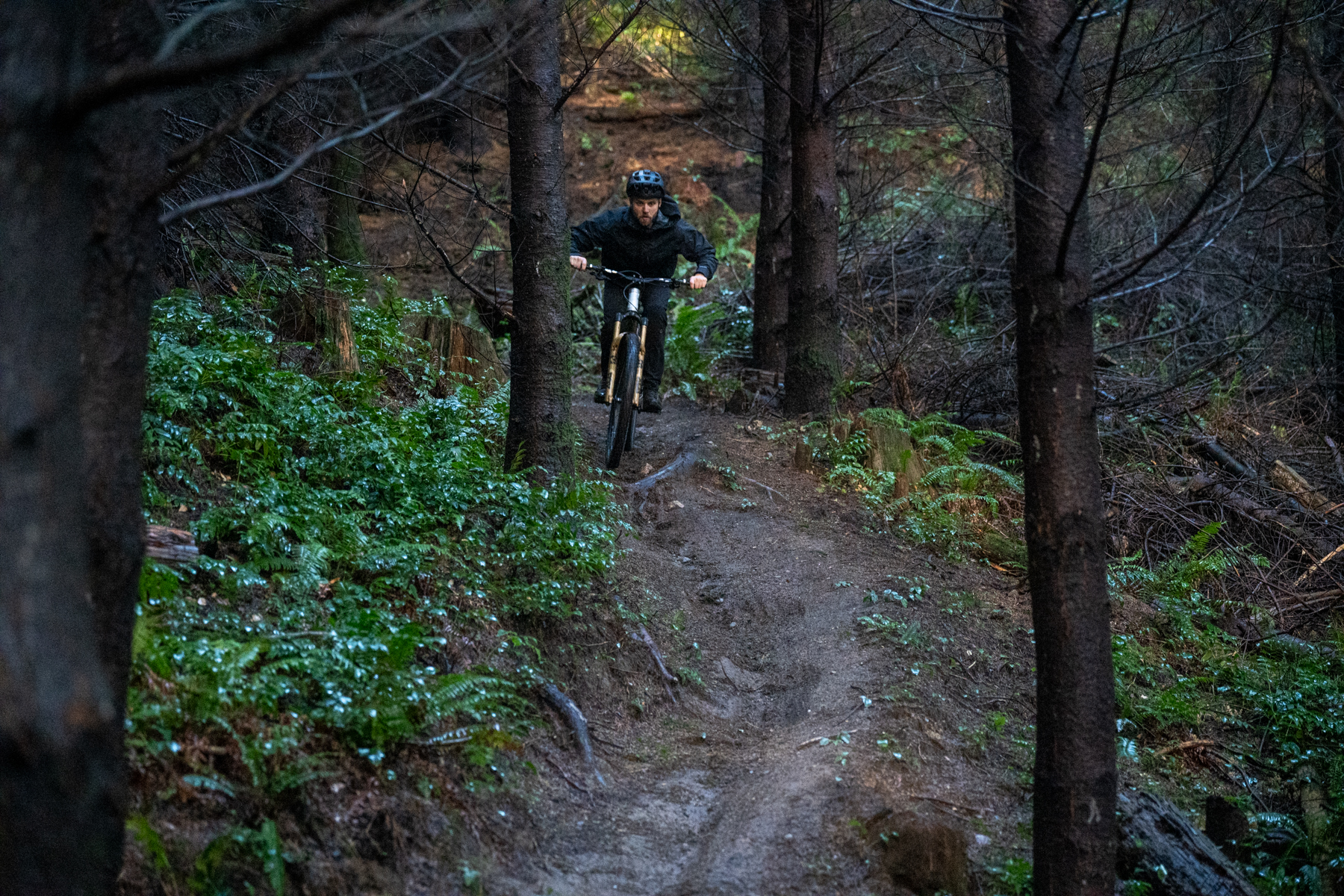
It’s also worth noting that folks on the XL and XXL frames are going to have a hard time fitting a dual-crown fork. The 140 mm headtube on the Large frame is already pushing it for the maximum crown spacing on every current dual-crown fork I’ve had my hands on; the 150 and 160 mm ones on the bigger sizes are going to require taller drop upper crowns to fit.
I was able to squeeze a few options onto the Large frame with a standard headset, but eventually had a 56 mm upper cup made for Cane Creek Slamset internals to buy myself a little more wiggle room (thanks to Adam Prosise for the machining on that one).
Short-Travel Mode
I’ve experimented a bit with the short-travel setting on the G1, using a 210×55 mm shock to drop it down to 140/152 mm rear travel, paired with a 150 mm travel fork. The G1 manages to span all three shock / wheel travel setups impressively coherently, but the short travel one doesn’t work as well for me as the other two.
In short, dropping to the short travel mode makes the G1 a bit more lively and a little quicker handling than it is in the standard Enduro setup, but it’s still more stable and hard-charging than I’d generally want for a mid-travel Trail bike. Shortening the travel just feels like it takes more away from the G1’s descending performance on faster, rougher trails than it gives back in either pedaling efficiency or when descending more mellow, rolling ones. It’s cool to have the option, but I wouldn’t recommend the G1 to most people who are planning to primarily ride it in the short travel mode, unless you’re after a rather specific combo of something that still handles more like an Enduro bike than a typical ~150mm-travel one, but with more lively, poppy-feeling suspension.
The Large frame is unquestionably the right size for me in the Enduro and DH setups, but I wonder if the Medium frame might work better in the Trail configuration. Mostly, I think that sizing down would help make the short-travel configuration feel a bit quicker handling and sharper in a way that would set it apart from the Enduro setup more. The sizing doesn’t feel too different between the two configurations, but the short-travel one feels, if anything, a touch bigger when standing up and descending. If I were to size down, I’d need to reconfigure some things to make the seated cockpit feel a bit bigger (e.g., sliding the seat back on the rails), and I’m not entirely sure that I’d prefer the result, but there’s still a solid chance that I might.
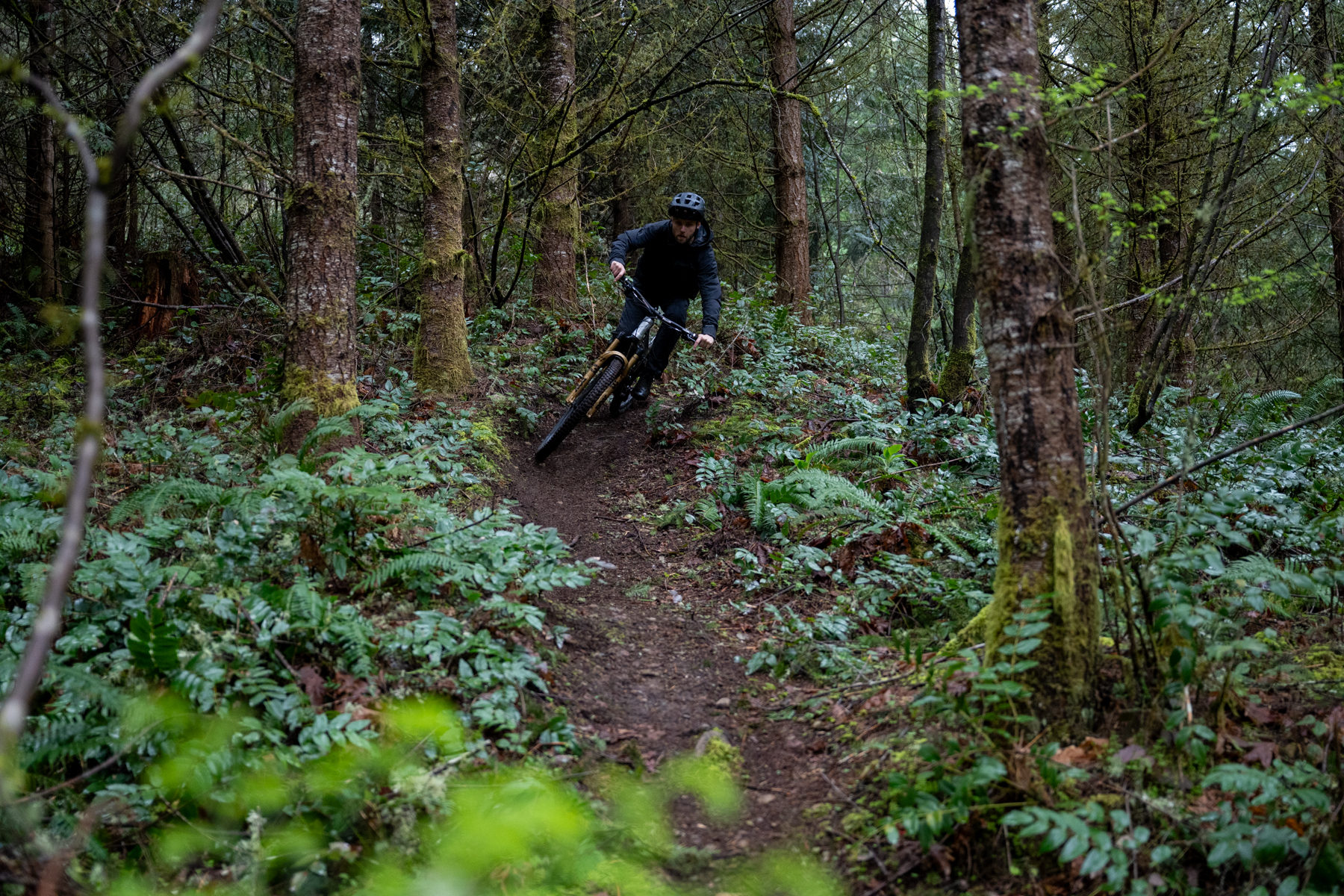
Who’s It For?
There’s one big picture answer here, and a few more granular ones. First and foremost, the G1 is an aggressive, gravity-oriented bike that wants to be pushed hard on fast, technical descents irrespective of how you set it up, at least within reason. The G1 is hugely adaptable, but that adaptability lets you fine-tune the fit, handling, and suspension performance of the G1 to your liking — those adjustments can’t transform it into something that it fundamentally isn’t.
Among bikes that also fit that gravity-oriented brief, the G1 stands out in a few ways. The biggest one is just how fine-tunable it is, though I don’t think you need to want to dive into the myriad options to appreciate the G1. At a baseline, it brings a combination of stable handling plus somewhat lively, energetic suspension that makes it more nimble than its geometry figures might suggest, which isn’t quite like anything else I’ve been on. The G1 also pedals pretty efficiently, and its ability to run both short- and long-travel setups is, if not quite entirely unique (looking at you, Kavenz), is certainly a rarity. If any of those things appeals to you, there’s not much else like the G1.
Bottom Line
Geometron made its name pushing bike geometry forward into the modern era, and while the new G1 doesn’t look nearly as radical by modern standards as their earlier bikes did when they launched, the frontiers of gravity bike geometry have shifted. We’re seeing an evolution toward longer chainstays and taller stack heights, and the new G1 is, once again, leading the charge.
But it’s not just a curiosity or an experiment. The G1 is a hugely adjustable, well-refined take on an aggressive, hard-charging Enduro bike and there’s a lot to like about it, whether or not you’re inclined to take full advantage of its ample adjustability. It’s just a very good, notably aggressive Enduro bike, full stop, and it’s earned a place in my quiver going forward.
Deep Dive Comparisons
BLISTER+ members and those who purchase our Digital Access Pass can check out our Deep Dive comparisons linked below. Get our Digital Access Pass to view all our Deep Dives and Flash Reviews, or become a BLISTER+ member today to get access to that and a LOT more, including the best worldwide Outdoor Injury Insurance, exclusive deals and discounts on skis, personalized gear recommendations from us, and much more.
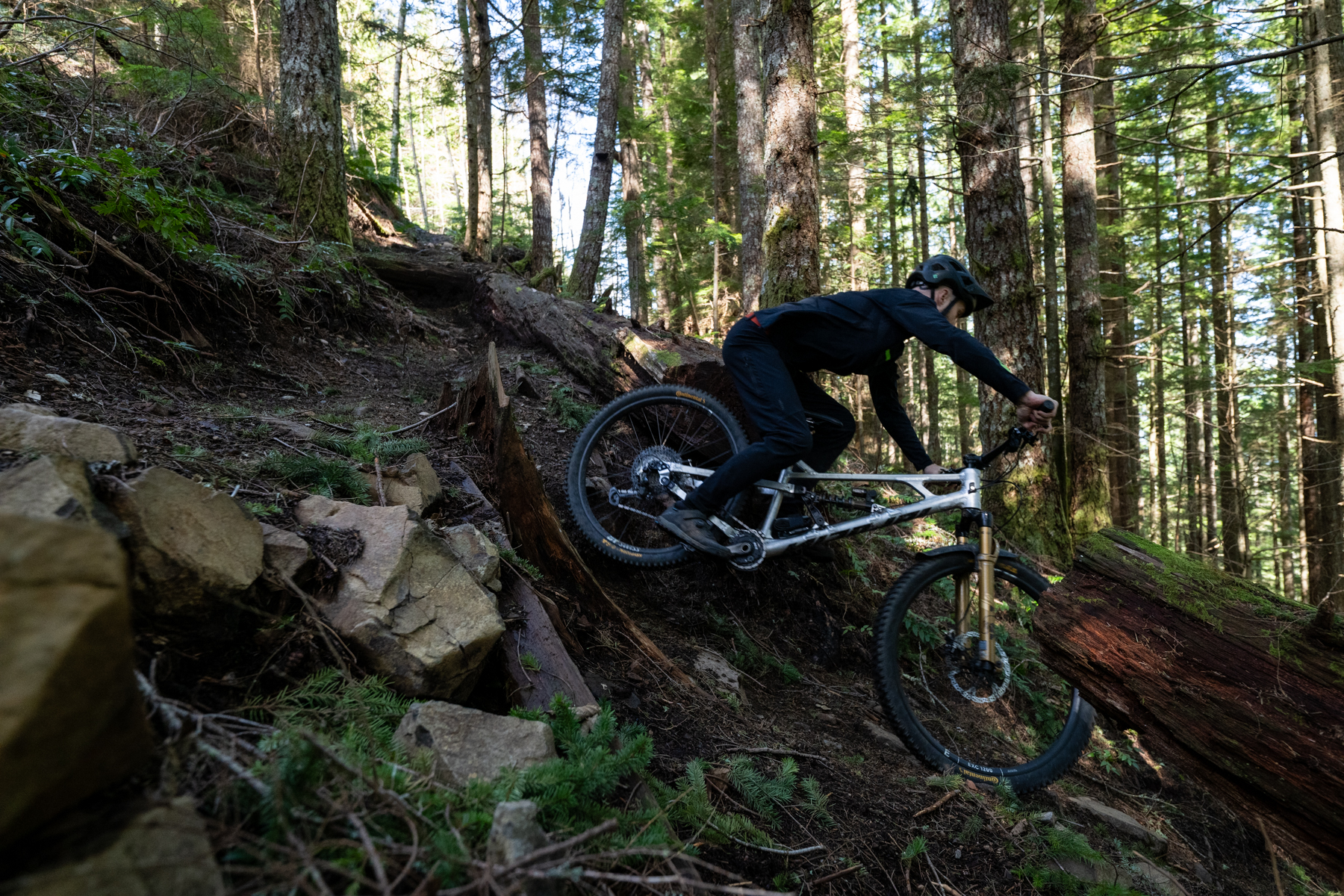
Deep Dive: Nicolai / Geometron G1
We compare the Nicolai / Geometron G1 to first-generation G1, RAAW Madonna V3, Privateer 161 V2, Chromag Lowdown, and Contra MC.
Blister’s Flash Reviews and Deep Dives are accessible to those who purchase one of our paid subscriptions
To get our comprehensive Deep Dives and our initial, unfiltered reports on new gear, become a member and receive many other services, deals, and discounts.
If you’re already an active member, please log in.
(If you’re already logged in and a member in good standing and seeing this message in error, please refresh this page in your browser.)

Although the nominal reach might have gotten shorter, the taller stack creates a longer reach, when you actually set your handlebar to a certain height.
Essentially you are measuring the reach higher up on the steerer. More stack adds about 0.4 X that amount to the reach at a certain a height. So, 50mm more stack equates to about 20mm more reach at a given stem height.
(I know David knows this, but it’s not really called out in the text)
As a 6’5”/196cm tall rider, I’d love to try one of those XXL’s. I might finally find a bike that is too big for me!
I really love what they are doing here. If only they routed the cable and hoses through the headset, it would be perfect ;-0
@tjaard I’m 6’6” and rode an XXL G1 for a while, but ended up sizing down to an XL and am much happier. I basically had to be game on all the time and commit super hard forward in order to get enough grip. Which is scary if you ride extremely steep skiddy stuff like I do. And requires pretty extreme lean angles to generate grip and exit speed on flatter corners. The XL with longer chainstays and a stupid tall riser bar was the ticket for me. Much more balanced
I suspected that might be the case. When I run some numbers, my XXL Stumpy Evo (also with stupid high stem and bar) is pretty similar in proportions to many well reviewed bikes in size L for 6’ reviewers.
Then again, this new one has substantially longer chainstays, so that might well negate that need to get forward.
Either way, the taller stack heights are awesome for us tall folks.
I have always liked what Nicolai was doing, and they have done some great improvements to this version.
Based off of old interviews with Chris Porter, I was expecting to be the next Geometron to be single pivot w/ spherical bearings and a linkage driven fork with a custom EXT shock
How flexy is the rear triangle? Ive heard the old ones at least would buzz tires frequently from lateral flex.
The new one is appreciably stiffer. It’s not mega stiff in the grand scheme of things, but more so than the prior-gen.
Stiffest rear on an enduro bike you tried? asking for someone who likes to ride sideways